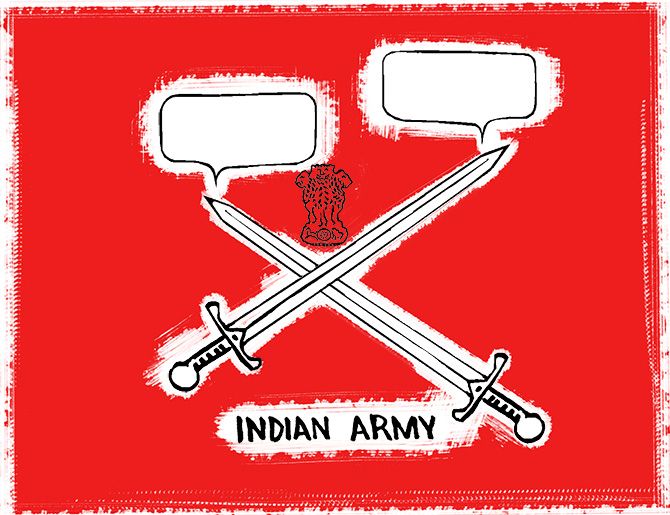'When India's adversaries are going all out in information warfare, the Indian Army will have to think out of the box to effectively counter them,' says Colonel S Dinny (retd).
Illustration: Dominic Xavier/Rediff.com

The recent controversy over a proposed code of conduct for veterans of the Indian Army brought to the fore once again the communication gap between the highest policy making establishment in the Indian Army and all other concerned stake-holders.
This was preceded by some other policy issues which were again marred by needless controversies.
In most of the cases it must be noted that the intention of the policy-makers in the Indian Army was truthful and in keeping with the highest professional ethos of the organisation.
But the perceptions created amongst the stake-holders were totally the opposite.
There is thus a perception misalignment on many issues between the highest policy-makers in the Indian Army and all others who are directly or indirectly affected by these policies or decisions.
One of the key reasons for this perception misalignment is due to the lack of effective communication at the highest levels. For obvious reasons, this communication by itself has to be strategic in nature.
Robert T Hasting Jr, who worked in the US department of defence, described strategic communication as the synchronisation of images, actions and words to achieve a desired effect.
Communication is strategic when it is completely consistent with the organisation's mission, vision, values and objectives. The ultimate goal of communication is thus to influence the behaviour of the target audience.
As far as the Indian Army is concerned, the target audience is its serving soldiers and veterans, their families, the Indian public at large and also the minds of the decision-makers and influencers of other foreign countries, especially those who are considered our adversaries.
With the advent of social media, the influence of civil society on the armed forces has increased exponentially.
Gone are the days when troops posted in isolated cantonments and remote places were completely oblivious to the happenings elsewhere. Today's soldier with a smart phone is connected to the entire globe and is being bombarded every single moment with a plethora of both information and misinformation in the form of messages, pictures and videos.
The earlier langar gupshup or 'dining room gossip', which mainly revolved around his battalion, is now based on WhatsApp groups involving his relatives, friends and a whole lot of other social acquaintances or even complete strangers.
In this scenario, even before a policy or a perspective plan is decided by the highest policy-makers, the stake-holders have already discussed it, shared the information or misinformation about it through social media platforms and, most importantly, formed their opinion on it.
If the issue is contentious in nature, then it is immediately taken up by the media and discussed at the national and international level.
However, even in this complex environment, the Indian Army still continues to primarily rely on the traditional method of dissemination of information, both internally and externally. These include the bureaucratic form of letter correspondence, through formal interactions with troops, veterans and families at various levels of commands and also through the use of army intranet.
Apart from this, a limited engagement with media is also carried out for dissemination of information.
The stark contrast is evident between the 'official-correct' information reaching the intended target audience days or even months after it has been disseminated and the 'informal-unofficial' and most of the times 'incorrect' information in the form of WhatsApp or Facebook messages reaching them instantly.
Although the Indian Army does have its presence in social media, for matters of strategic communication it is grossly inadequate.
The policy-makers in the system can no longer remain isolated in this era where 'vulnerabilities to falsehood' is on the rise.
When India's adversaries are going all out in information warfare, the Indian Army will have to think out of the box and break away from the 'traditionalist mentality' to effectively counter them.
The only limitation to this is its own imagination.
The Indian Army must exploit the power of social media constructively, with all due precautions taken, to highlight its key policy issues including the rationale, thereby creating a perception alignment between policy-makers and the intended target audience.
If future conflicts, as stated by Emile Simpson in War From The Ground Up, are going to be centred on the 'competition to impose meaning on people', it is of paramount importance that the Indian Army quickly adapt itself to win the battle of narratives through perception alignment of its own vision and objectives, both within and outside the organisation.
Colonel S Dinny (retd) took voluntary retirement from the Indian Army on October 1, 2019, after serving as an infantry officer for about 22 years in which time he did multiple tenures in the Kashmir valley, the north east and along the Line of Actual Control. He has also served as a military observer with the UN in Congo.









